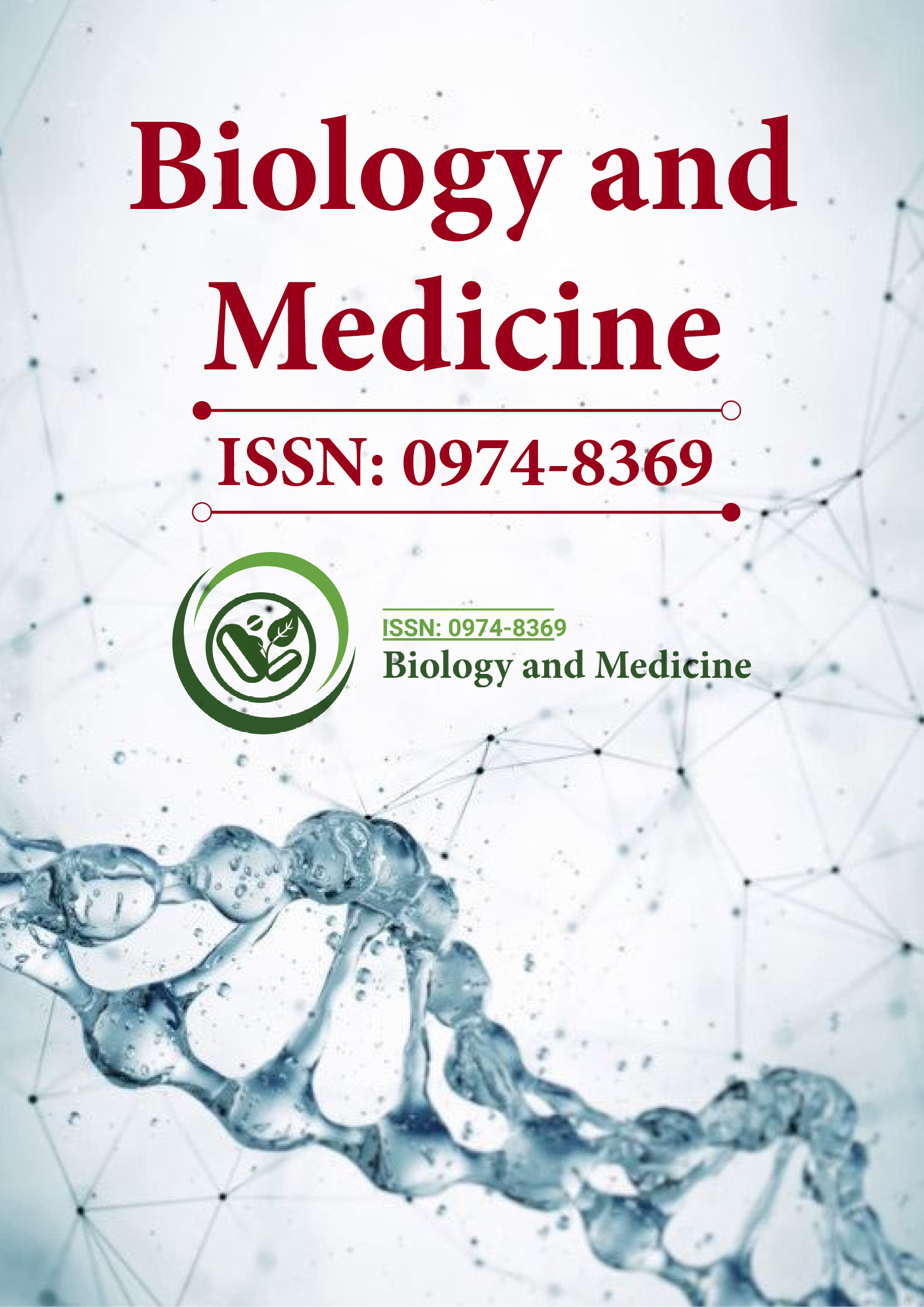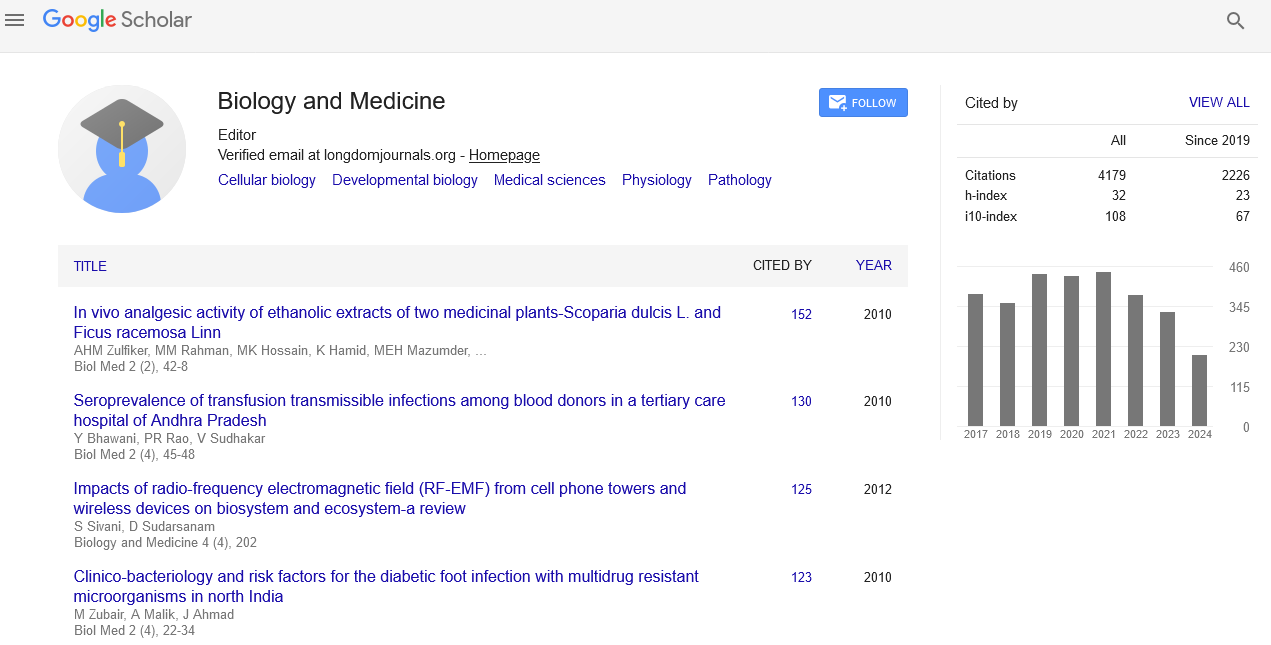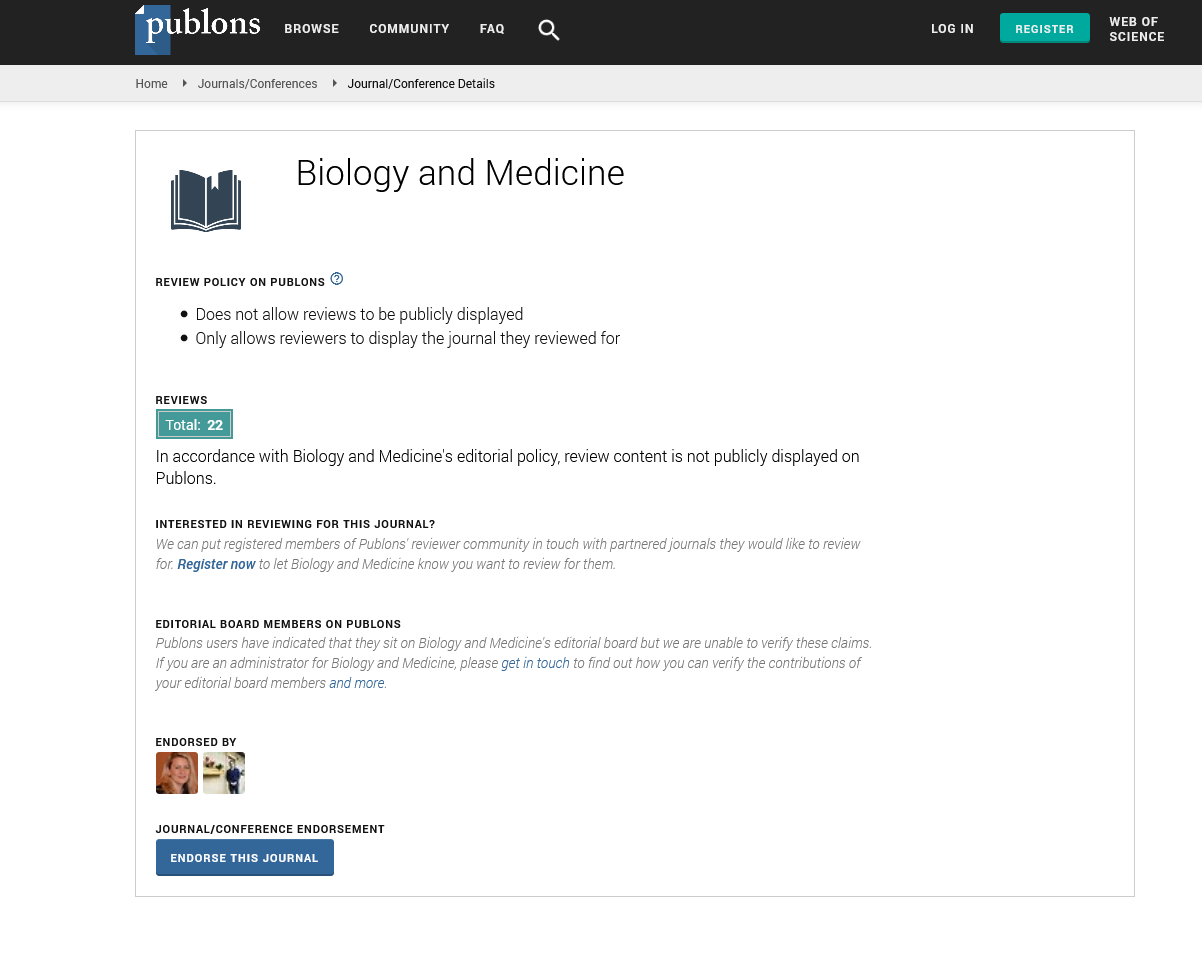Indexed In
- Open J Gate
- Genamics JournalSeek
- CiteFactor
- Cosmos IF
- Scimago
- Ulrich's Periodicals Directory
- Electronic Journals Library
- RefSeek
- Hamdard University
- EBSCO A-Z
- Directory of Abstract Indexing for Journals
- OCLC- WorldCat
- Proquest Summons
- Scholarsteer
- ROAD
- Virtual Library of Biology (vifabio)
- Publons
- Geneva Foundation for Medical Education and Research
- Google Scholar
Useful Links
Share This Page
Journal Flyer

Open Access Journals
- Agri and Aquaculture
- Biochemistry
- Bioinformatics & Systems Biology
- Business & Management
- Chemistry
- Clinical Sciences
- Engineering
- Food & Nutrition
- General Science
- Genetics & Molecular Biology
- Immunology & Microbiology
- Medical Sciences
- Neuroscience & Psychology
- Nursing & Health Care
- Pharmaceutical Sciences
Short Communication - (2025) Volume 17, Issue 2
Extremophiles in Human Health: Lessons from Life in Harsh Environments
Lrika Elan*Received: 12-Feb-2025, Manuscript No. BLM-25-28801; Editor assigned: 14-Feb-2025, Pre QC No. BLM-25-28801 (PQ); Reviewed: 28-Feb-2025, QC No. BLM-25-28801; Revised: 07-Mar-2025, Manuscript No. BLM-25-28801 (R); Published: 14-Mar-2025, DOI: 10.35248/0974-8369.25.17.774
Description
Extremophiles organisms that thrive in extreme environmental conditions represent a frontier in biological and medical research with vast untapped potential. Found in habitats such as deep-sea vents, acidic lakes, and radioactive environments, these microbes have evolved remarkable adaptations that allow them to survive where most life cannot. This paper explores the biological mechanisms that confer such resilience, including thermostable enzymes, efficient DNA repair systems, and robust cellular structures. Particular attention is given to their medical and biotechnological applications, such as in molecular diagnostics (e.g., PCR), drug development, synthetic biology, and disease modeling.
Extremophiles not only offer a wealth of novel biomolecules with therapeutic potential but also provide insight into protein folding and genome stability relevant to human diseases like cancer and neurodegeneration. Despite challenges such as cultivation and ethical concerns, advances in metagenomics and bioengineering are accelerating the discovery and application of extremophile-based innovations. By studying life at the edges of habitability, we uncover new possibilities to address human health challenges in equally extreme conditions.
Life thrives in places where we once thought it couldn't. Deep beneath ocean floors, inside acidic lakes, and amidst scalding volcanic vents live extremophiles organisms that flourish under extreme environmental conditions. These microscopic survivors are more than just biological curiosities; they offer profound insights and practical tools that may help us solve some of the most pressing challenges in human health.
Extremophiles are classified based on the type of extreme environment they inhabit. Thermophiles survive in high temperatures, while psychrophiles endure extreme cold. Halophiles tolerate high salt concentrations, acidophiles live in acidic conditions, and radiophiles withstand intense radiation. Each group has evolved specialized biological mechanisms to maintain stability and function where most other life forms would perish. These mechanisms—especially at the molecular level—have direct implications for medicine, biotechnology, and health care.
Perhaps the most familiar application of extremophiles is in molecular diagnostics. The Polymerase Chain Reaction (PCR), a cornerstone of modern genetics and medical testing, relies on Taq polymerase, an enzyme originally isolated from the thermophilic bacterium Thermus aquaticus. This enzyme remains stable at high temperatures required during DNA amplification, making PCR rapid and reliable. Beyond Taq, other extremophile-derived enzymes have been adopted for their stability under stress such as high pH, salinity, or pressure—expanding possibilities in diagnostic kits, drug synthesis, and even industrial medicine.
But extremophiles offer more than just tough enzymes. Many produce unique bioactive compounds as a survival strategy in harsh environments. These include antimicrobial peptides, antioxidants, and anti-cancer agents that may be harnessed for new drug discoveries. For example, Deinococcus radiodurans, known for its resistance to radiation, produces powerful antioxidants and has an extraordinary ability to repair DNA damage. Its mechanisms are of particular interest in developing treatments for aging, radiation exposure, and cancer.
Additionally, extremophiles offer new models for understanding human stress biology. The ability of certain microbes to fold proteins correctly at extreme heat, or repair DNA after massive damage, can inform therapies for diseases such as Alzheimer’s, which involve protein misfolding, or degenerative disorders linked to genetic instability. Their cell membranes, proteins, and DNA-repair enzymes offer blueprints for designing robust therapeutic systems and drug delivery platforms.
In a more futuristic direction, extremophile genetics are now being integrated into synthetic biology and biomedical engineering. Researchers are designing artificial cells and biosensors using components from extremophiles that can function under physiological or even pathological stress conditions. Imagine implantable sensors that continue working accurately inside a feverish or inflamed body, or enzymes that can deliver drugs effectively even in the acidic environment of a tumor.
Moreover, extremophile-based solutions may support health in less obvious but important ways. With growing interest in the human microbiome, extremophile-derived enzymes and microbes are being explored for gut and skin health. Their resilience makes them ideal candidates for probiotic supplements designed to survive the acidic stomach environment or topical treatments for people living in polluted or extreme environments.
Of course, the road from extremophile to clinical application is not without obstacles. Many extremophiles are difficult to culture in the lab, and a large portion of their genetic material remains uncharacterized. There are also ethical considerations regarding the exploitation of life in pristine or remote environments, such as deep-sea vents or polar ice caps. Nonetheless, advances in metagenomics and machine learning are making it easier to analyze and utilize extremophile DNA without the need for physical cultivation.
Conclusion
Extremophiles teach us that resilience is not just a feature of life, but its very foundation. Their ability to adapt, survive, and thrive under extraordinary conditions holds valuable lessons and tools for human health. From thermostable enzymes enabling modern diagnostics to unique bioactive compounds with therapeutic potential, extremophiles are already reshaping how we think about medicine, biotechnology, and disease treatment. Their cellular mechanisms illuminate new paths in understanding aging, stress biology, and genetic repair, while their genes are increasingly incorporated into synthetic biology solutions designed for harsh or pathological environments. While scientific and ethical challenges remain, the continued exploration of extremophile biology promises to unlock innovative strategies to heal, protect, and enhance human life guided by life forms that flourish where few others can.
References
- Odgers CL, Jensen MR. Annual research review: Adolescent mental health in the digital age: Facts, fears, and future directions. J Child Psychol Psychiatry. 2020;61(3):336-348. [Crossref] [Google Scholar] [PubMed]
- Small GW, Lee J, Kaufman A, Jalil J, Siddarth P, Gaddipati H, et al. Brain health consequences of digital technology use. Dialogues Clin Neurosci. 2022. [Crossref] [Google Scholar] [PubMed]
- YÃÂ?±lmaz D, YÃÂ?±ldÃÂ?±z M. Analysis of the mobile phone effect on the heart rate variability by using the largest lyapunov exponent. J Med Syst. 2010;34(6):1097. [Crossref] [Google Scholar] [PubMed]
- Andrzejak R, Poreba R, Poreba M, Derkacz A, Skalik R, Gac P, et al. The influence of the call with a mobile phone on heart rate variability parameters in healthy volunteers. Ind Health. 2008;46(4):409-417. [Crossref] [Google Scholar] [PubMed]
- Saini BS, Pandey A. Effect of mobile phone and BTS radiation on heart rate variability. IJRET. 2013;2:662-666. [Google Scholar]
- Dogra AK, Saini I, Sood N. Impact of wireless cellular network on heart rate variability. In 2020 International Conference on Computational Intelligence for Smart Power System and Sustainable Energy. 2020;1-4. [Crossref] [Google Scholar]
- Alassiri M, Alanazi A, Aldera H, Alqahtani SA, Alraddadi AS, Alberreet MS, et al. Exposure to cell phones reduces heart rate variability in both normal-weight and obese normotensive medical students. Explore. 2020;16(4):264-270. [Crossref] [Google Scholar] [PubMed]
- Ahamed VT, Karthick NG, Joseph PK. Effect of mobile phone radiation on heart rate variability. Comput Biol Med. 2008;38(6):709-12. [Crossref] [Google Scholar] [PubMed]
- Parazzini M, Ravazzani P, Tognola G, Thuróczy G, Molnar FB, Sacchettini A, et al. Electromagnetic fields produced by GSM cellular phones and heart rate variability. J Bio Electro Magnetics. 2007;28(2):122-129. [Crossref] [Google Scholar] [PubMed]
- Perrotta AS, Jeklin AT, Hives BA, Meanwell LE, Warburton DE. Validity of the elite HRV smartphone application for examining heart rate variability in a field-based setting. J Strength Cond Res. 2017;31(8):2296-302. [Crossref] [Google Scholar] [PubMed]
Citation: Elan L (2025). Extremophiles in Human Health: Lessons from Life in Harsh Environments. Bio Med. 17:774.
Copyright: © 2025 Elan L. This is an open-access article distributed under the terms of the Creative Commons Attribution License, which permits unrestricted use, distribution and reproduction in any medium, provided the original author and source are credited.


